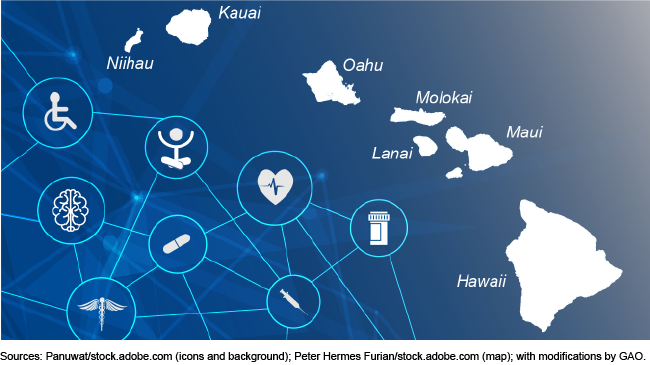Native Hawaiian Health Care Systems Program: Services, Funding, and Oversight
Fast Facts
Native Hawaiians throughout Hawaii can receive primary care, health education, and nutrition services through the Native Hawaiian Health Care Systems—five systems that serve the state's seven inhabited islands.
The systems customize their services to meet the needs of their island communities, including culturally appropriate services and health care providers that speak local dialects. These services rely heavily upon federal grants—such as from the Department of Health and Human Services—which are the primary source of revenue for all five systems.
We reviewed the services, funding, and oversight of the health care systems in this report.

Highlights
What GAO Found
The Native Hawaiian Health Care Systems Program, administered by the Health Resources and Services Administration (HRSA), aims to improve access to services for Native Hawaiians living in Hawaii. The program provides funding to five Native Hawaiian Health Care Systems—each serving different islands—and an oversight body named Papa Ola Lokahi. (See figure.)
Map of the Native Hawaiian Health Care Systems

The systems, which vary in size, offer a range of health care and other services, including primary care, mental health, and fitness programs. The systems also serve as a bridge to Western medicine and integrate traditional Native Hawaiian values, beliefs, and practices. In 2022, across the five systems, the number of patients who had medical visits ranged from 315 to 3,413, and the amount of revenue received ranged from $3.5 to nearly $9.7 million. Federal grants, which include the Native Hawaiian Health Care Systems Program awards, were the primary source of revenue for all the systems.
HRSA awards program funds via a limited competition grant that is open only to the five systems and Papa Ola Lokahi. According to HRSA and Papa Ola Lokahi officials, HRSA relies on recommendations from Papa Ola Lokahi to determine the amount of funding to award each of the systems each year. Fiscal year 2022 program funding for each system ranged from $2.8 to $3.4 million.
HRSA uses several processes to oversee the program and help the systems and Papa Ola Lokahi meet program requirements. These include: annual reviews of operational and financial reports, in-person operational site visits once every 3 years, and monitoring calls to discuss program updates and other topics.
Why GAO Did This Study
The estimated 328,000 Native Hawaiians living in the state of Hawaii as of 2022 face significant health disparities compared to other populations in the state. The Native Hawaiian Health Care Systems Program, administered by HRSA, aims to improve Native Hawaiians' access to disease prevention, health promotion, and primary care services in Hawaii. The systems are part of the broader health care infrastructure in Hawaii, which includes other medical service providers from which Native Hawaiians can seek care.
House Report 117-96 includes a provision for GAO to review health care services available to Native Hawaiians living in Hawaii. This report describes (1) the provision of services and other characteristics of the Native Hawaiian Health Care Systems; (2) how Native Hawaiian Health Care Systems Program funds are awarded; and (3) how HRSA oversees the program.
GAO reviewed reports that the systems submitted to HRSA, which include data on the services provided, patients served, and revenue received in 2022. GAO also reviewed agency documents and program funding data from fiscal years 2018 through 2022 to cover at least one full (3-year) grant cycle and include the most recent fiscal year data available at the time of the review. In addition, GAO interviewed HRSA officials and officials from each of the five systems and Papa Ola Lokahi.
For more information, contact Michelle B. Rosenberg at (202) 512-7114 or RosenbergM@gao.gov.
